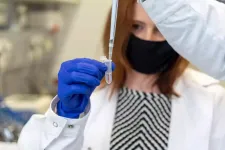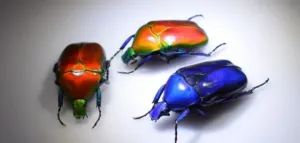How a COVID-19 infection changes blood cells in the long run
New research suggests that a coronavirus infection alters the biomechanical properties of red and white blood cells, in some cases for months -- a possible explanation for long COVID
2021-06-29
(Press-News.org) Using real-time deformability cytometry, researchers at the Max-Planck-Zentrum für Physik und Medizin in Erlangen were able to show for the first time: Covid-19 significantly changes the size and stiffness of red and white blood cells - sometimes over months. These results may help to explain why some affected people continue to complain of symptoms long after an infection (long Covid).
Shortness of breath, fatigue and headaches: some patients still struggle with the long-term effects of a severe infection by the SARS-CoV-2 coronavirus after six months or more. This post Covid-19 syndrome, also called long covid, is still not properly understood. What is clear is that -- during the course of the disease -- often blood circulation is impaired, dangerous vascular occlusions can occur and oxygen transport in is limited. These are all phenomena in which the blood cells and their physical properties play a key role.
To investigate this aspect, a team of scientists led by Markéta Kubánková, Jochen Guck, and Martin Kräter from the Max-Planck-Zentrum für Physik und Medizin, the Max Planck Institute for the Science of Light (MPL), the Friedrich Alexander University Erlangen-Nuremberg and the German Centre for Immunotherapy measured the mechanical states of red and white blood cells. "We were able to detect clear and long-lasting changes in the cells -- both during an acute infection and even afterwards," reports Professor Guck, currently managing director of MPL. The research group has now published their results in the renowned journal Biophysical Journal.
To analyse the blood cells, they used a self-developed method called real-time deformability cytometry (RT-DC), which has recently been recognized with the prestigious Medical Valley Award. In this method, the researchers send the blood cells through a narrow channel at high speed. In the process, the leukocytes and erythrocytes are stretched. A high-speed camera records each of them through a microscope, and custom software determines which cell types are present, and how big and deformed they are. Up to 1000 blood cells can be analysed per second. The advantage of the method: It is fast and the cells do not have to be labelled in a laborious procedure.
The method could help as an early warning system to detect future pandemics by unknown viruses
The biophysicists from Erlangen examined more than four million blood cells from 17 patients acutely ill with Covid-19, from 14 people who had recovered and 24 healthy people as a comparison group. They found that, for example, the size and deformability of the red blood cells of patients with the disease deviated strongly from those of healthy people. This indicates damage to these cells and could explain the increased risk of vascular occlusion and embolisms in the lungs. In addition, the oxygen supply, which is one of the main tasks of the erythrocytes, may be impaired in infected persons. Lymphocytes (one type of white blood cell responsible for the acquired immune defense) were in turn significantly softer in Covid-19 patients, which typically indicates a strong immune reaction. The researchers made similar observations for neutrophil granulocytes, another group of white blood cells involved in the innate immune response. These cells even remained drastically altered seven months after the acute infection. "We suspect that the cytoskeleton of immune cells, which is largely responsible for cell function, has changed," explains Markéta Kubánková, first author of the research article. In her view, real-time deformability cytometry has the potential to be used routinely in the diagnosis of Covid-19 -- and even to serve as an early warning system against future pandemics caused by as yet unknown viruses.
INFORMATION:
Original publication
Markéta Kubánková, Bettina Hohberger, Jakob Hoffmanns, Julia Fürst, Martin Herrmann, Jochen Guck, Martin Kräter
Physical phenotype of blood cells is altered in COVID-19
Biophysical Journal, 2021, ISSN 0006-3495
[Attachments] See images for this press release:

ELSE PRESS RELEASES FROM THIS DATE:
2021-06-29
In two journal articles, a University of Houston biomedical researcher reports a step forward in diagnosing intestinal diseases, including colorectal cancer, ulcerative colitis and Crohn's disease using stool proteins. The current gold standard for colon cancer testing measures blood (hemoglobin) present in stool, and tests for inflammatory bowel disease (IBD) measure levels of calprotectin, a protein that detects inflammation in the intestines.
"The unique aspect of both research reports is that we are looking at stool samples comprehensively, ...
2021-06-29
INDIANAPOLIS - Ten IU School of Medicine researchers out of a team of 11 scientists, are responsible for the findings of a new study they conducted to investigate alternative ways to treat kidney infections. Their work, which is published in the high-quality research journal Nature Communications, examined how to utilize the kidneys' own internal infection fighting capabilities to treat and even prevent kidney infections, with the knowledge that eventually antibiotics won't work.
According to statistics, urinary tract infections or UTIs are one of the most frequent bacteria-causing ...
2021-06-29
A new class of illusion, developed by a visual artist and a psychology researcher, underscores the highly constructive nature of visual perception.
The illusion, which the creators label "Scintillating Starburst," evokes illusory rays that seem to shimmer or scintillate--like a starburst. Composed of several concentric star polygons, the images prompt viewers to see bright fleeting rays emanating from the center that are not actually there.
"The research illustrates how the brain 'connects the dots' to create a subjective reality in what we see, highlighting the constructive nature of perception," explains Pascal Wallisch, a clinical associate professor in New York University's Department ...
2021-06-29
Six antibody characteristics could help scientists identify which pregnant women are at risk of placental malaria infections, finds a study published today in eLife.
Malaria infections can be devastating for pregnant mothers, particularly during their first pregnancies. If malaria parasites invade the placenta, they can starve babies of nutrition, potentially causing low birth weight, preterm deliveries, stillbirths, and pregnancy loss. But not all women are susceptible to placental malaria infections, and the new study may help clinicians to identify those at risk and researchers to develop new therapies to protect pregnant women from malaria and related complications.
A protein made by malaria parasites called VAR2CSA allows them to attach ...
2021-06-29
New insight on how our experiences during a task or interaction shape our current mood has been published today in the open-access eLife journal.
The study suggests that early experiences may have a larger effect on our mood than more recent events. These findings hold implications for the timing of events in experimental or clinical settings, and suggest new directions for mood interventions tailored to individual patients.
People routinely report on their moods during everyday activities and when they interact with clinicians providing mental health care. It is commonly believed ...
2021-06-29
Rising nighttime temperatures are curbing crop yields for rice, and new research moves us closer to understanding why. The study found that warmer nights alter the rice plant's biological schedule, with hundreds of genes being expressed earlier than usual, while hundreds of other genes are being expressed later than usual.
"Essentially, we found that warmer nights throw the rice plant's internal clock out of whack," says Colleen Doherty, an associate professor of biochemistry at North Carolina State University and corresponding author of a paper on the work.
"Most people think plants aren't dynamic, but they are. Plants are constantly regulating ...
2021-06-29
A recent proof-of-concept study finds that a low-cost training program can reduce hazardous driving in older adults. Researchers hope the finding will lead to the training becoming more widely available.
"On-road training and simulator training programs have been successful at reducing car accidents involving older drivers - with benefits lasting for years after the training," says Jing Yuan, first author of the study and a Ph.D. student at North Carolina State University. "However, many older adults are unlikely to have access to these training programs or technologies."
"We developed a training program, ...
2021-06-29
Populations of Drosophila suzukii fruit flies - so-called "spotted-wing Drosophila" that devastate soft-skinned fruit in North America, Europe and parts of South America - could be greatly suppressed with the introduction of genetically modified D. suzukii flies that produce only males after mating, according to new research from North Carolina State University.
D. suzukii are modified with a female-lethal gene that uses a common antibiotic as an off switch. Withholding the antibiotic tetracycline in the diet of larvae essentially eliminates birth of female D. suzukii flies as the modified male flies successfully mate with females, says Max Scott, an NC State entomologist who is the corresponding author of a paper describing the research.
"We use a genetic female-lethal system - a ...
2021-06-29
Researchers from the Laboratory of Oncolytic-Virus-Immuno-Therapeutics (LOVIT) at the LIH Department of Oncology (DONC) are working on the development of novel anticancer strategies based on oncolytic viruses, "good" viruses that can specifically infect, replicate in and kill cancer cells. In particular, the LOVIT team elucidated the mechanism through which the H-1PV cancer-destroying virus can attach to and enter cancer cells, thereby causing their lysis and death. At the heart of this process lie laminins, and specifically laminin γ1, a family of proteins on the surface of a cancer cell to which this virus binds, and which therefore act as the 'door' through which the virus enters the cells. The findings, which were published in the prestigious ...
2021-06-29
Beetles are creatures with built-in body armor. They are tiny tanks covered with hard shells, also known as exoskeletons, protecting their soft, skeleton-less bodies inside. In addition to providing armored protection, the beetle's exoskeleton offers functions like sensory feedback and hydration control. Notably, the exoskeletons of many beetles are also brilliantly colored and patterned, which enhances visual communication with other beetles and organisms.
Ling Li, lead investigator and assistant professor in mechanical engineering, has joined colleagues from six other universities to investigate the interplay between mechanical and optical performance ...
LAST 30 PRESS RELEASES:
[Press-News.org] How a COVID-19 infection changes blood cells in the long run
New research suggests that a coronavirus infection alters the biomechanical properties of red and white blood cells, in some cases for months -- a possible explanation for long COVID



